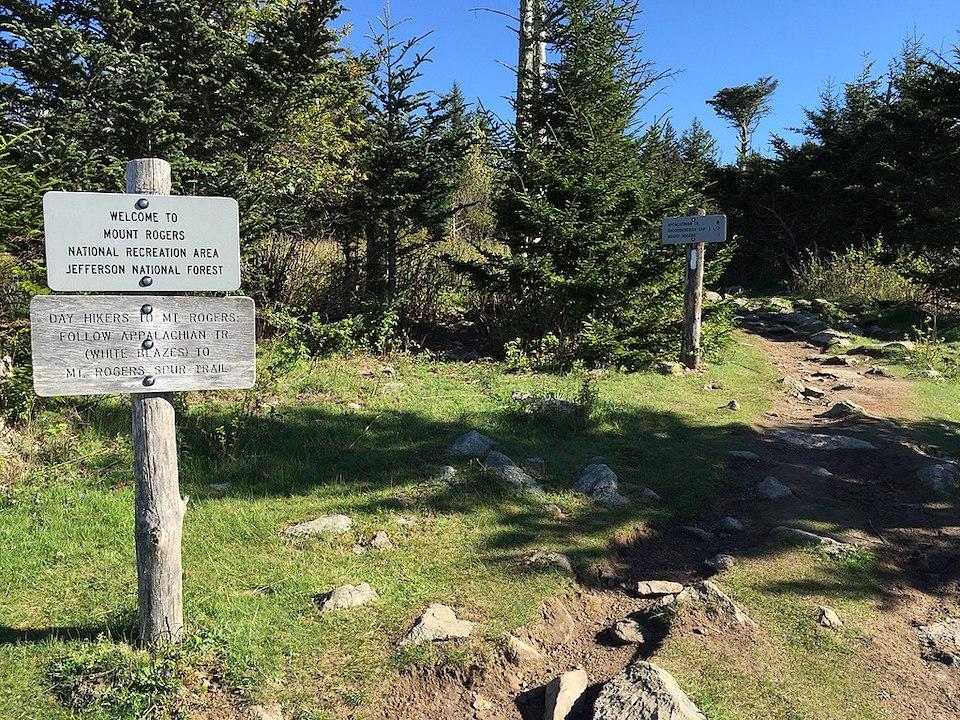
A man was in custody and charged with murder after machete attacks on the Appalachian Trail in Virginia. This is the view south along the A.T. upon entering the Mount Rogers National Recreation Area within the Jefferson National Forest from Grayson Highlands State Park in Grayson County, Virginia/Famartin via wikipedia, CC BY-SA 4.0
Editor's note: This updates with information from the criminal complaint filed by the FBI in the case and deletes outdated material.
A Massachusetts man who previously had been accused of threatening hikers on the Appalachian Trail was in jail Monday on charges of murdering one hiker and injuring another with a machete or knife.
James L. Jordan, of West Yarmouth, Mass., in April allegedly had threatened other A.T. hikers in Unicoi County, Tennessee, according to the complaint filed by FBI Special Agent Micah J. Childers.
On Friday night the man approached a camp of four backpackers on a section of the A.T. in the Wythe County, Virginia, within the George Washington and Jefferson National Forest in Virginia.
The 30-year-old, who "was acting disturbed and unstable, and was playing his guitar and singing" when he approached the four, began threatening them, saying he would pour gasoline on their tents and "burn them to death," the complaint (attached below) added.
The four hikers decided to pack up and head down the trail, but before they could Jordan attacked one of them with his machete or knife, then chased down a second and attacked her, the FBI agent wrote.
'Victim #2 fell to the ground and played dead, at which point Jordan left to find his dog," the complaint went on. "Victim #2 then ran down the trail towards Smyth County. Victim #2 received assistance from a male and female hiker, who assisted in helping her hike an additional 6 miles into Smyth County, where they called 911."
Shortly after 6 a.m. local time Saturday a tactical team from the Wythe County Sheriff's Office reached the campsite where the incident began and arrested Jordan, the complaint said. The first victim of the attack also was discovered there and pronounced dead. Later that day the second victim was interviewed in the Bristol Regional Medical Center, and identified Jordan as her attacker, the filing added.
The complaint did not indicate whether Jordan resisted the officers. It also did not name the victims or the other hikers.
While the section of trail from Virginia 16 at Mount Rogers National Recreation Area Headquarters (mile 534.2) north to Virgina 42 (mile 558.2) near Ceres/Groseclose had initially been closed, it reopened Sunday, according to the Appalachian Trail Conservancy.
"I commend local law enforcement in Wythe and Smyth Counties for mobilizing successful rescue and tactical operations in this remote region," Thomas T. Cullen, the U.S. Attorney for the Western District of Virginia, said in a prepared statement. "Thanks to their efforts, the suspect was safely apprehended and the seriously wounded victim received critical medical care. We will continue to work with our state and local partners to bring the perpetrator of this senseless and brutal attack to justice."
The murder was the first on the iconic footpath that roams from Springer Mountain, Georgia, to Mount Katahdin in Maine since the summer of 2011. Scott A. Lilly, 30, of South Bend, intended to hike from central Maryland south to Springer Mountain, Georgia, the southern terminus of the famed trail when he was killed that summer. His partially buried body was found August 12 along a side trail to the Cow Camp Gap Shelter in George Washington–Jefferson National Forest. No one has been brought to trial in that case.
Lilly’s last known contact was from the shelter July 31, 2011. His body was not identified until August 16. That shelter is about 0.6 mile east of the A.T. along the Old Hotel Trail, which loops around and rejoins the A.T. again about two miles north.
A state medical examiner in January 2012 determined that Lilly, who used the trail name "Stonewall," was suffocated. Most of the man's gear went missing, including new trail shoes (Walmart’s Ozark Trail brand), a blue or purple backpack, a Nintendo game, and “an A.T. handbook."
The latest murder marks at least the 11th on the trail since a murder along the A.T. was investigated in 1974 in a Georgia case.



Comments
How did the FBI get involved in this case? I always thought that all U.S. Forest Service properties are under proprietery jurisdiction?
So, what would be the best way to protect yourself?
That's a tough one, Igor, though this sort of attack is highly isolated. Certainly, hiking with a companion or two is helpful. In this case it wasn't, but the perpetrator is said to be struggling with mental issues, something else you're not likely to encounter on the A.T.
Some will recommend carrying a firearm, though that might not be allowed in all jurisdictions.
For what it's worth, this incident wouldn't stop me from heading out on the A.T.
Anyone else have any suggestions?
Press charges when assaulted. Then the perp might not be let out to kill the next time.
Situational awareness is all one individual can do.
I'm 63 years old and have been hiking and backpacking for 50 years. I carry a large can of 'Bear spray' and a 'K-bar' or survival knife. Both for protection from the 2 legged and 4 legged predators.
I'd be carrying bear spray.
The AT has had an increasing problem with the homeless and people who are mentally unstable. Something the ATC has tried to ignore.